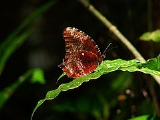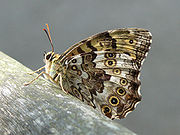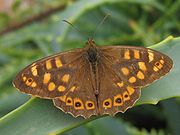
Elymniini
Encyclopedia
The Elymniini are one of the large tribe
s of the browns subfamily (Satyrinae
) in the brush-footed butterfly
family
(Nymphalidae
). Sometimes, they are elevated to subfamily status as Elymniinae.
usually treated as a junior synonym. But this is not correct as it seems: according to cladistic analysis of mtDNA COI and NADH dehydrogenase
subunit
1 sequence
data, the Parargina – i.e. the group around Pararge
, including at least the very similar Lasiommata
as well as Tatinga and its the doubtfully distinct relative Chonala – form a distinct lineage after all, immediately basal to the distinctly apomorphic Mycalesina and the more plesiomorphic Lethina proper; the accurate circumscription of these subtribes remains to be determined however. In any case, these three constitute the bulk of the tribe's diversity. The Elymniina and Zetherina, by contrast, quite certainly form a less diverse clade that diverged early on in the evolution of the tribe.
Subtribe Elymniina
Subtribe Zetherina

 Subtribe Lethina (including Parargina
Subtribe Lethina (including Parargina
, but paraphyletic)
 Subtribe Mycalesina
Subtribe Mycalesina
s:
They are usually all assumed to belong to the Lethina; due to the non-monophyly
of that group, all that can be said is that they are probably fairly basal members of the more diverse radiation. Fossils from near the time of such divergences often yield interesting insight into the patterns of evolution
.
Tribe (biology)
In biology, a tribe is a taxonomic rank between family and genus. It is sometimes subdivided into subtribes.Some examples include the tribes: Canini, Acalypheae, Hominini, Bombini, and Antidesmeae.-See also:* Biological classification* Rank...
s of the browns subfamily (Satyrinae
Satyrinae
Satyrinae, the satyrines or satyrids, commonly known as the Browns, is a subfamily of the Nymphalidae . They were formerly considered a distinct family, Satyridae. This group contains nearly half of the known diversity of brush-footed butterflies...
) in the brush-footed butterfly
Butterfly
A butterfly is a mainly day-flying insect of the order Lepidoptera, which includes the butterflies and moths. Like other holometabolous insects, the butterfly's life cycle consists of four parts: egg, larva, pupa and adult. Most species are diurnal. Butterflies have large, often brightly coloured...
family
Family (biology)
In biological classification, family is* a taxonomic rank. Other well-known ranks are life, domain, kingdom, phylum, class, order, genus, and species, with family fitting between order and genus. As for the other well-known ranks, there is the option of an immediately lower rank, indicated by the...
(Nymphalidae
Nymphalidae
The Nymphalidae is a family of about 5,000 species of butterflies which are distributed throughout most of the world. These are usually medium sized to large butterflies. Most species have a reduced pair of forelegs and many hold their colourful wings flat when resting. They are also called...
). Sometimes, they are elevated to subfamily status as Elymniinae.
Systematics
They are commonly subdivided into four subtribes (tribes when considered a subfamily). The largest tribe is called Lethina, with PararginaParargina
Parargina is a subtribe of butterflies of the subfamily Satyrinae.-Genera:* Chonala* Kirinia* Lasiommata* Lopinga* Nosea* Orinoma* Pararge* Rhaphicera* Tatinga...
usually treated as a junior synonym. But this is not correct as it seems: according to cladistic analysis of mtDNA COI and NADH dehydrogenase
NADH dehydrogenase
NADH dehydrogenase is an enzyme located in the inner mitochondrial membrane that catalyzes the transfer of electrons from NADH to coenzyme Q...
subunit
Protein subunit
In structural biology, a protein subunit or subunit protein is a single protein molecule that assembles with other protein molecules to form a protein complex: a multimeric or oligomeric protein. Many naturally occurring proteins and enzymes are multimeric...
1 sequence
DNA sequence
The sequence or primary structure of a nucleic acid is the composition of atoms that make up the nucleic acid and the chemical bonds that bond those atoms. Because nucleic acids, such as DNA and RNA, are unbranched polymers, this specification is equivalent to specifying the sequence of...
data, the Parargina – i.e. the group around Pararge
Pararge
Pararge is a genus of butterfly of the Nymphalidae family.-Species:* Pararge aegeria – Speckled Wood * Pararge xiphia – Madeiran Speckled Wood...
, including at least the very similar Lasiommata
Lasiommata
Lasiommata is a genus of butterflies of the subfamily Satyrinae in the family Nymphalidae.-Species:* Lasiommata megera * Lasiommata paramegaera * Lasiommata maera...
as well as Tatinga and its the doubtfully distinct relative Chonala – form a distinct lineage after all, immediately basal to the distinctly apomorphic Mycalesina and the more plesiomorphic Lethina proper; the accurate circumscription of these subtribes remains to be determined however. In any case, these three constitute the bulk of the tribe's diversity. The Elymniina and Zetherina, by contrast, quite certainly form a less diverse clade that diverged early on in the evolution of the tribe.
Selected genera
Subtribes are listed in the presumed phylogenetic sequence, from the most ancient to the most advanced; genera are listed alphabetically. Some species are also listed.Subtribe Elymniina
- Elymnias HübnerJacob HübnerJacob Hübner was a German entomologist. He was the author of Sammlung Europäischer Schmetterlinge , a founding work of entomology.-Scientific career:...
, 1818 – palmflies- Elymnias hypermnestraElymnias hypermnestraThe Common Palmfly, Elymnias hypermnestra, is a species of satyrid butterfly found in south Asia.-Description:As some other species in the genus Elymnias, the Common Palmfly presents a precostal cell on the hindwings and a hair tuft of androconial scales on dorsal discal cell of hindwings.This...
– Common Palmfly
- Elymnias hypermnestra
Subtribe Zetherina
- Callarge Leech, 1892
- Ethope Moore, 1866 (sometimes placed in Lethina)
- Neorina Westwood, 1850 (sometimes erroneously placed in Lethina)
- Neorina patriaNeorina patriaThe White Owl, Neorina patria, is a species of satyrine butterfly found in India , Burma Thailand Laos and Vietnam....
– White OwlNeorina patriaThe White Owl, Neorina patria, is a species of satyrine butterfly found in India , Burma Thailand Laos and Vietnam....
- Neorina patria
- Penthema Doubleday, 1848
- Zethera Felder, 1861


Parargina
Parargina is a subtribe of butterflies of the subfamily Satyrinae.-Genera:* Chonala* Kirinia* Lasiommata* Lopinga* Nosea* Orinoma* Pararge* Rhaphicera* Tatinga...
, but paraphyletic)
- Aphysoneura Karsch, 1894
- Chonala Moore, 1893 (might belong in Tatinga)
- EnodiaEnodia (butterfly)Enodia is a genus of butterflies of the subfamily Satyrinae in the family Nymphalidae.-Species:* Enodia portlandia – Southern Pearly-eye or Pearly-eye...
HübnerJacob HübnerJacob Hübner was a German entomologist. He was the author of Sammlung Europäischer Schmetterlinge , a founding work of entomology.-Scientific career:...
, [1819] – pearly-eyes- Enodia anthedonEnodia anthedonThe Northern Pearly-eye is a species of Satyrinae that occurs in North America, where it is found from central Saskatchewan and eastern Nebraska east to Nova Scotia, south to central Alabama and Mississippi....
– Northern Pearly-eye
- Enodia anthedon
- Hanipha Moore, 1880
- Kirinia Moore, 1893 (including Esperarge)
- LasiommataLasiommataLasiommata is a genus of butterflies of the subfamily Satyrinae in the family Nymphalidae.-Species:* Lasiommata megera * Lasiommata paramegaera * Lasiommata maera...
Westwood, 1841 – walls and wallbrowns (formerly in Pararge)- Lasiommata maera – Large WallLarge WallThe Large Wall Brown is a butterfly in the family Nymphalidae. The species is common in continental Europe. Though it is an avid flyer It is seldom seen on flight in strong wind. Its preferred habitats are edges of the forests and unmanaged clearings on forested areas. The larva eats full grown...
, Large Wall Brown - Lasiommata megera – Wall BrownWall BrownThe Wall Brown, Lasiommata megera, is a butterfly in the family Nymphalidae . It is widespread in the Palearctic ecozone with a large variety of habitats and a number of generations a year.-Range:...
, Wall - Lasiommata menavaLasiommata menavaThe Dark Wall, Lasiommata menava, is a species of satyrine butterfly found in India....
– Dark Wall - Lasiommata petropolitanaLasiommata petropolitanaThe Northern Wall Brown is a butterfly species belonging to the family Nymphalidae. It can be found in large parts of Europe, from the Pyrenees and Alps up to Scandinavia and Finland, up to Russia and Siberia....
– Northern Wall Brown - Lasiommata schakraLasiommata schakraThe Common Wall, Lasiommata schakra, is a species of satyrine butterfly found in South Asia.-Description:Shows slight sexual dimorphism. Male upperside ground colour silky brown; cilia of both wings whitish...
– Common Wall
- Lasiommata maera – Large Wall
- LetheLethe (genus)Lethe is a butterfly genus from the subfamily Satyrinae in the family Nymphalidae. It includes the treebrowns, woodbrowns, foresters and their relatives. The species in the genus Lethe occur in temperate-tropical southern and eastern Asia, up to Indonesia....
– treebrowns, woodbrowns, foresters and relatives - LopingaLopingaLopinga is a genus of butterfly of the Nymphalidae family.-Species:* Lopinga achine – Woodland Brown* Lopinga catena* Lopinga deidamia * Lopinga dumetorum * Lopinga eckweileri...
Moore, 1893 (formerly in Pararge)- Lopinga achine – Woodland BrownWoodland BrownThe Woodland Brown is a butterfly in the family Nymphalidae. The species is widely distributed, but uncommon and local in continental Europe. Most of the suitable habitats for the species have been transformed to gardening. The Woodland Brown may be found in warm openings of damp unmanaged mature...
- Lopinga achine – Woodland Brown
- Mandarinia Leech, 1892
- Neope Moore, 1866
- Ninguta Moore, 1892
- Nosea Koiwaya, 1993
- Orinoma Gray, 1846
- ParargeParargePararge is a genus of butterfly of the Nymphalidae family.-Species:* Pararge aegeria – Speckled Wood * Pararge xiphia – Madeiran Speckled Wood...
Hübner, 1819- Pararge aegeria – Speckled WoodSpeckled WoodThe Speckled Wood is a butterfly found in and on the borders of woodland throughout much of the Palearctic ecozone.In North Europe, Central Europe , Asia Minor, Syria, Russia and Central Asia where subspecies P. a. tircis occurs it is brown with pale yellow or cream spots and darker upperwing...
- Pararge aegeria – Speckled Wood
- Ptychandra C. & R. Felder, 1861
- Rhaphicera Butler, 1867
- Rhaphicera mooreiRhaphicera mooreiThe Small Tawny Wall, Rhaphicera moorei, is a species of satyrine butterfly found in West China, India and Tibet....
– Small Tawny Wall
- Rhaphicera moorei
- SatyrodesSatyrodesThe Satyrodes is a genus of Satyrinae that is native to North America.-Species:*Satyrodes eurydice – Eyed Brown or Marsh Eyed Brown*Satyrodes appalachia – Appalachian Brown or Woods Eyed Brown...
Scudder, 1875- Satyrodes eurydiceSatyrodes eurydiceThe Eyed Brown or Marsh Eyed Brown is a species of Satyrinae that is native to North America.There are two subspecies—the nominate species, Eyed Brown , and the Smokey Eyed Brown The Eyed Brown or Marsh Eyed Brown (Satyrodes eurydice) is a species of Satyrinae that is native to North...
– Eyed Brown
- Satyrodes eurydice
- Tatinga Moore, 1893 (might include Chonala)

- BicyclusBicyclusBicyclus is a butterfly genus from the subfamily Satyrinae in the family Nymphalidae.-Species:*Bicyclus abnormis *Bicyclus albocincta *Bicyclus alboplaga *Bicyclus amieti Libert, 1996...
Kirby, 1871 - Bletogona C. & R. Felder, 1867
- Hallelesis Condamin, 1961
- HeteropsisHeteropsis (butterfly)Heteropsis is a butterfly genus from the subfamily Satyrinae in the family Nymphalidae.-Species:*Heteropsis adolphei *Heteropsis alaokola *Heteropsis anceps...
Westwood, 1850 (including Admiratio, Henotesia, Houlbertia, Masoura) - MycalesisMycalesisThe bushbrowns, Mycalesis, are a genus of brush-footed butterflies. They are common in the warm regions from Central Asia to Australia, and have a high diversity in South Asia and the Wallacea....
– bushbrowns - Nirvanopsis
- OrsotriaenaOrsotriaenaOrsotriaena is a genus of butterflies found in South Asia, Southeast Asia, and Australia. It contains only one species, Orsotriaena medus...
– Smooth-eyed Bush-brown - Pseudomycalesis Tsukada & Nishiyama, 1979
Fossil record
Several prehistoric genera have been described from fossilFossil
Fossils are the preserved remains or traces of animals , plants, and other organisms from the remote past...
s:
- Neorinella Martins Neto et al., 1993
- Neorinopsis
- Pseudoneorina Nel & Descimon, 1986
- Satyrites Scudder, 1872
They are usually all assumed to belong to the Lethina; due to the non-monophyly
Monophyly
In common cladistic usage, a monophyletic group is a taxon which forms a clade, meaning that it contains all the descendants of the possibly hypothetical closest common ancestor of the members of the group. The term is synonymous with the uncommon term holophyly...
of that group, all that can be said is that they are probably fairly basal members of the more diverse radiation. Fossils from near the time of such divergences often yield interesting insight into the patterns of evolution
Evolution
Evolution is any change across successive generations in the heritable characteristics of biological populations. Evolutionary processes give rise to diversity at every level of biological organisation, including species, individual organisms and molecules such as DNA and proteins.Life on Earth...
.

